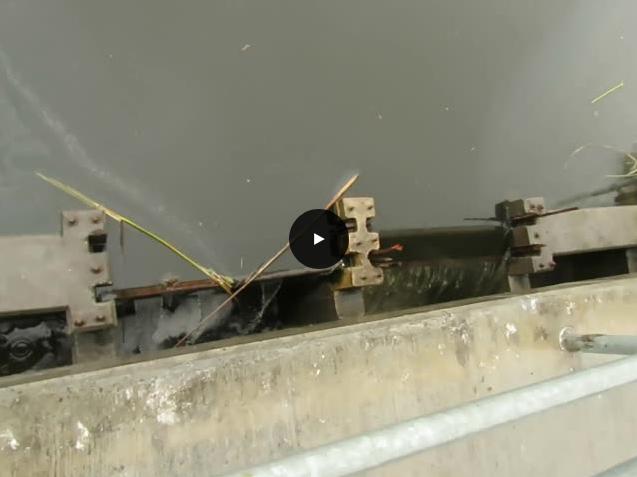
Hello Mr. Kang, and Waterboards, Agencies, County Supervisors, Legislative Persons, City of Los Angeles, Coastal Commission Commissioners and Staff,
Grassroots Coalition requests adherence to Senator Pavley’s SB 1168, which requires the reasonable and beneficial use of water, for its application in use for BALLONA WETLANDS ECOLOGICAL RESERVE. Grassroots Coalition is also requesting adherence and enforcement of all local, state and federal protective laws including but not limited to the Porter-Cologne Act and the Clean Water Act and recent underground gas reservoir/oilfiled gas leakage including SB4, Water Code 10783.
https://leginfo.legislature.ca.gov/faces/billNavClient.xhtml?bill_id=201...
Section 3, Part 2.74 “Sustainable Groundwater Management Act” discusses the legislation intent as providing protection to the ‘greatest extent possible’. Information on the amount of groundwater extraction, natural and artificial recharge, and groundwater evaluations are critical for effective management of groundwater.
10728 Groundwater Planning
(a) Groundwater elevation data (An overall review and evaluation of Ballona’s groundwater elevation data is needed which includes the Playa Vista site and its impacts upon the
groundwater elevation.)
10727.4. In addition to the requirements of Section 10727-2, a groundwater sustainability plan shall include, where appropriate and in collaboration with the appropriate local agencies, all of the following:
(A few among many Pertinent Parts are listed below)
(a) Control of saline water intrusion.
b) Wellhead protection areas and recharge areas.
(Per Water Code 13751 and 13752 Well Completion Reports-Playa Vista has no known well completion reports for all of the long-term dewatering wells at occupied development sites that are being used to lower the aquifer levels to keep the gas mitigation intake systems free of water. GC requests agency collaboration in determination of the cumulative dewatering ongoing at Playa Vista and its cumulative impacts upon the aquifers from the Playa Vista pre- development to the present.)
(c) Migration of contaminated groundwater.
(Inclusive but not limited to Playa del Rey, SoCalGas oilfield/reservoir gas migration)
(e) Replenishment of groundwater extractions.
(i) Impacts on groundwater dependent ecosystems
Ballona Wetlands is a unique, coastal, predominantly freshwater wetland, that after a decades long battle between the developers and the public to save it as habitat, was acquired by the public, via the Wildlife Conservation Board (WCB) in 2003-4. The WCB, in tandem with the California Fish & Game Commission assigned the strongest protective standard available by designating Ballona Wetlands as an Ecological Reserve. Ballona Wetlands Ecological Reserve is a water dependent ecosystem and as such is allocated the greatest resource protection to its historical habitat and its sustaining freshwaters under current laws.
Currently, the DEIR for Ballona’s restoration contains no discussion of the freshwater aquifers of Ballona and there are no hydrology studies contained in the DEIR that provide evaluation of the aquifers and impacts upon them from and by-- either Playa Vista groundwater/surface dewatering and diversion and/or any potential of any further saltwater intrusion contamination. The breeches to the Ballona Channel in the past by the Army Corps had no 408 Permits for the breeching and no studies were done to evaluate the harm to the freshwater aquifers. (FOIA requested info by GC)
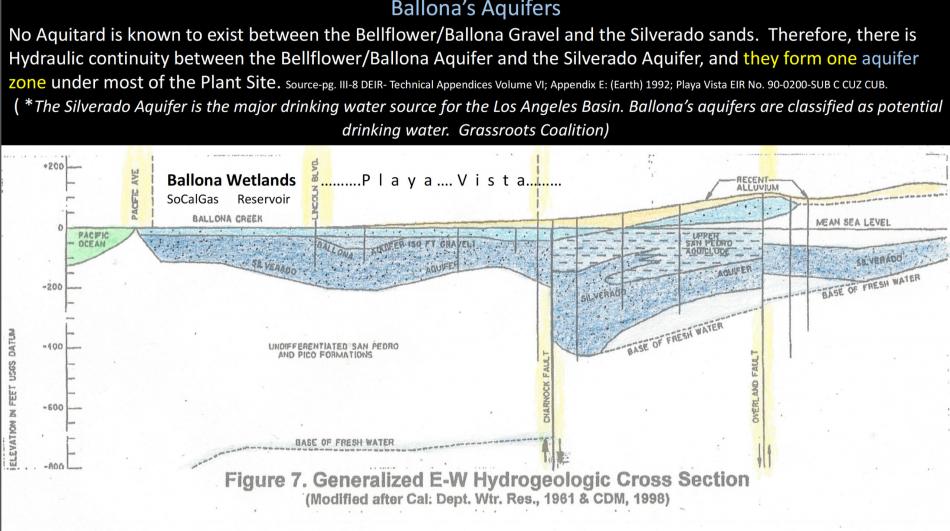 BACKGROUND
BACKGROUND
Development pressure by Maguire Thomas & Partners and subsequently Playa Capital LLC, has long been the primary driving force behind deal making arrangements and preliminary permits given to the developers prior to any Environmental Impact studies of the area taking place. The divvying up of Ballona, that was revealed in the 1990 Land Use, Settlement Agreement between the California Coastal Commission and Friends of Ballona (which became part of the Army Corps of Engineers freshwater marsh system permit 90-4426-EV, and Coastal Development Permit 5-91-463 for Playa Vista’s flood control needs), incorrectly labeled Ballona as a salt marsh. This incorrect labeling excluded the scientific aquifer and hydrology studies written in the POLAND REPORT.
Poland is considered the grandfather and still leading authority of all the historic LA Basin groundwater studies. In 1990- 2003, Playa Vista’s developers were still intent upon portraying Ballona as a saltwater wetland, as they participated and became leaders of Friends of Ballona and created saltwater intrusion breeches along the Ballona Channel (Channel-an Army Corps project that opened a perpetual concreted channel to the ocean to offload LA CITY storm water to prevent flooding) and proceeded with their intent to dig out Ballona for their own flood control needs, and create a marina to the north of Ballona Channel in what is known as Area A (across from Fisherman’s Village). The slide below, shows this original development project as Areas A,B,C and D.
Ultimately, the public’s investigative work in tandem with LA City Building & Safety officials, illuminated oilfield gas migration hazards of the area inclusive of the numerous leakage problems associated with the storage of underground gas in the Playa del Rey oilfield by SoCalGas. These oilfield and SoCalGas reservoir leakage issues led to the prevention of any residential building being allowed by LA Building & Safety, west of Lincoln Blvd. A buffer zone was created and new, experimental gas mitigation systems became part of new METHANE CODES. 1) The Phase 1 of Playa Vista is subject to the PLAYA VISTA METHANE PREVENTION DETECTION AND MONITORING PROGRAM(PVMPDP) ORDINANCE AND 2) The CITYWIDE METHANE CODE utilizes much of the the PVMPDMP. (See attached PDF for visuals of recent Picarro methodology outgas testing and SoCalGas reservoir map, and Exploration Technologies Inc. (ETI) mapping of gas chimneys under Playa Vista and Ballona Wetlands.)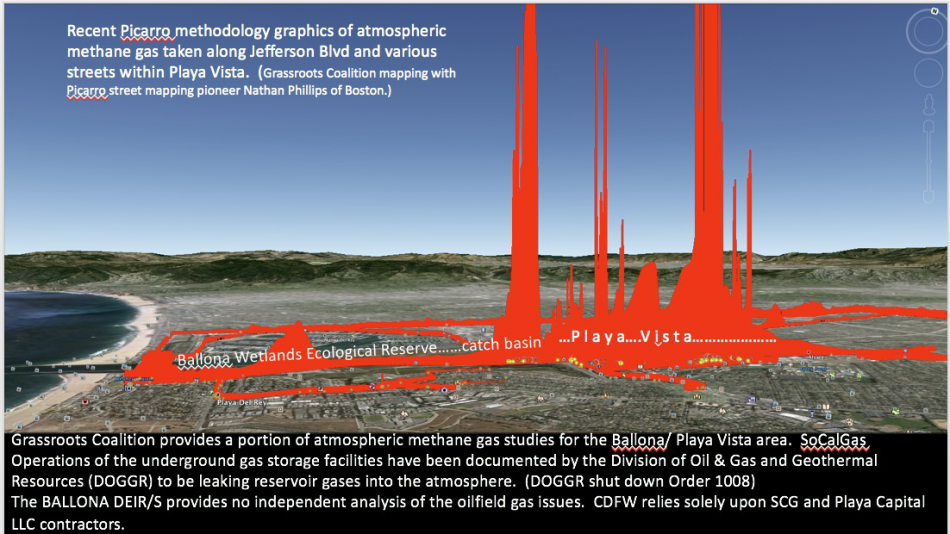
Playa Capital LLC became a ‘willing seller’ in 2003 and the public paid out $140 million for the Ballona properties known as Area A, B, C. Area D remains as Playa Vista inclusive of the east side of the flood control system known as the ‘Riparian Corridor’ portion of the freshwater marsh system. The freshwater diversion from this system drain into Ballona Channel thus, the freshwater is lost for any recharging of freshwater for Ballona Wetlands Ecological Reserve. The recent rainfall of 2018, is shown below as being thrown away into the Ballona Channel via the Main Drain that traverses north from the freshwater marsh to the Ballona Channel. Playa Capital LLC/Brookfield diversion control of this water continues to allow Ballona to dry out while agencies with ownership and also agencies with oversight authority have allowed the diversion.
The Ballona Public Trust wetlands are being utilized to service a private development which Grassroots Coalition believes to be an unlawful gifting of public resources.
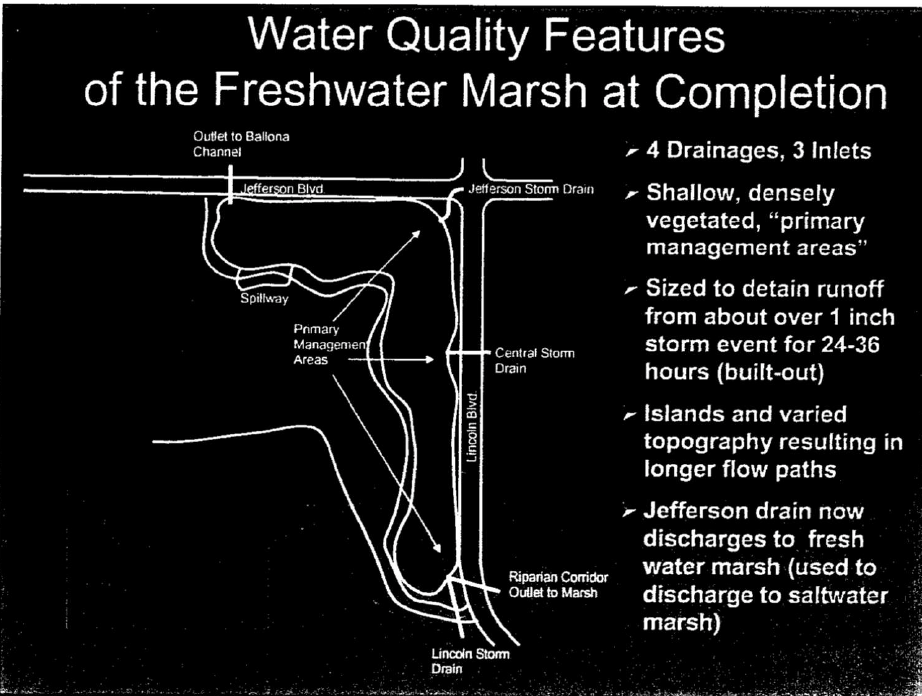
The Riparian Corridor contains the small waterway throughout its length that receives discharge of decontaminated water from Playa Vista toxic sites under the LA Regional Water Board’s authority per the Clean Up & Abatement Order 98-125. This area recently had a large illegal roadway built over its small and approved service pathway. LA Building & Safety cited approximately 17 Playa Capital LLC/ Brookfield entities for the unpermitted road building. The The California Dept. of Fish & Wildlife cited Playa Vista for violating their Streambed Alteration Agreement due to the unpermitted building. The road building, which buried portions of the slope to the waterway, occurred in endangered species habitat and was found to have allowed fill to run off into the waterway. Both violations outcomes are still pending.
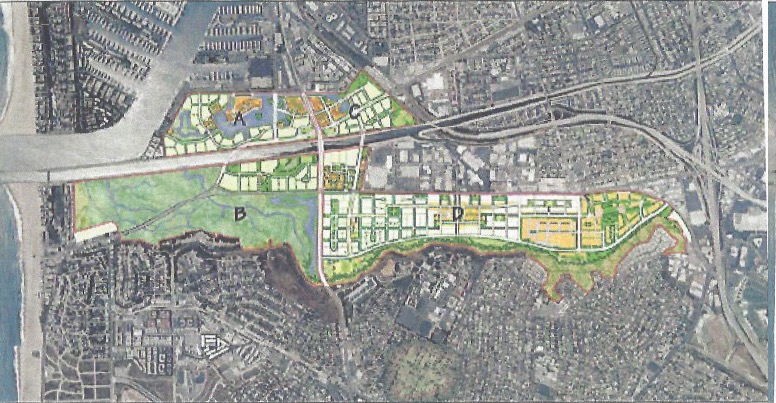
Playa Vista Concept Plan
Recently, Grassroots Coalition (GC) was compelled to intercede with a lawsuit to prevent Playa Capital LLC/Brookfield and the California Dept. of Fish & Wildlife(CDFW) from allowing continued degradation of the Ballona Wetlands by their mutual action of draining rainwaters through two illegal drains in Area B. The California Coastal Commission provided a formal investigation to which the CCC cited that the wetlands were being harmed via the unpermitted drainage devices and that both entities were in violation of the Coastal Act. GC prevailed in its actions and a Settlement Agreement ensued with CDFW applying for a Coastal Development Permit to cap the wells. The CDP was altered by the Coastal Commissioners in December of 2017 , leaving the capping as one CDP that has been completed and one CDP application remaining to take out the drains from Ballona.
A groundwater informational powerpoint created by the Nature Conservancy, highlights the need for groundwater/ surface water protection for ecosystem survival.
https://web.archive.org/web/20171208084946/http://groundwatercalifornia.org:80/
http://www.groundwatercalifornia.org/
This letter is one of a series of letters providing information and requests per the protection and restoration of Ballona Wetlands Ecological Reserve.
And, as additional information provided for Grassroots Coalition’s CAL EPA Complaints 25061 & 23608.
Thank you for your time in reviewing this material,
Patricia McPherson, Grassroots Coalition
- 4471 reads


